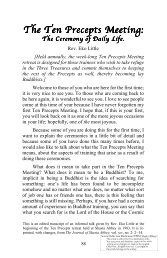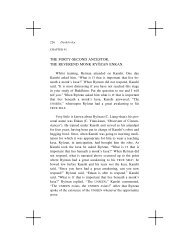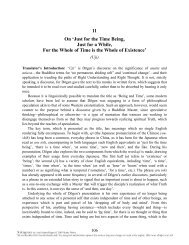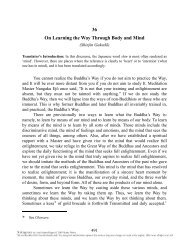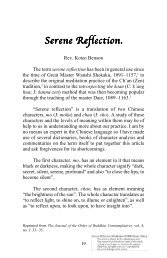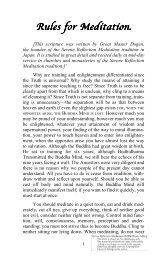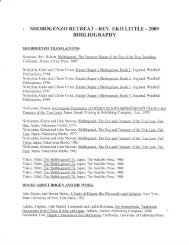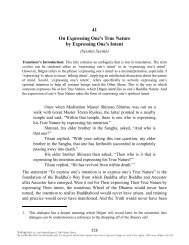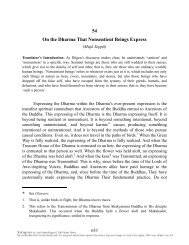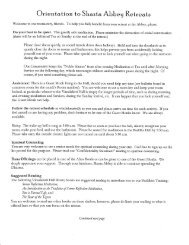Sansui Kyo - thezensite
Sansui Kyo - thezensite
Sansui Kyo - thezensite
You also want an ePaper? Increase the reach of your titles
YUMPU automatically turns print PDFs into web optimized ePapers that Google loves.
13<br />
On the Spiritual Discourses<br />
of the Mountains and the Water<br />
(<strong>Sansui</strong>kyō)<br />
Translator’s Introduction: If readers are not already familiar with the Zen Buddhist use of<br />
metaphorical language, they may find the following comments useful in grasping what Dōgen is<br />
talking about in this Dharma discourse, which is baffling if its terms are taken only in their literal<br />
sense.<br />
It has been said that when the Sanskrit word dhyāna, meaning ‘meditation’ in the Zen<br />
Buddhist sense, was introduced into China, the Chinese had no word that was its equivalent, so<br />
the Sanskrit word was spelled out by using two Chinese characters according to their<br />
pronunciation: chan-na (pronounced like English ‘john-nah’). Over time, the term was shortened<br />
and the Mandarin pronunciation altered slightly to ch’an (pronounced like ‘tchahn’). In Japan,<br />
this character was pronounced as zen. Although there were other Chinese characters that had<br />
already been used for transliterating the Sanskrit sound dhyā, the one chosen in the present<br />
instance also carried an ancient meaning, one relevant to Dōgen’s discourse: ‘to bow respectfully<br />
to mountains and flowing water’.<br />
In the present discourse, Dōgen takes up the difference between the general, conventional use<br />
of the terms ‘mountain’ and ‘(flowing) water’ and their special use by the Chinese Zen Masters<br />
for pointing to spiritual matters. As previously indicated in notes to Dōgen’s earlier Dharma<br />
discourses, the term ‘mountain’ has several implications in Zen contexts. In this discourse in<br />
particular, ‘mountain’ is most often used as a descriptive epithet for one who is sitting in<br />
meditation, as still as a mountain among mountains (that is, one who is training among other<br />
members of the Buddhist Sangha), as well as for a wise and saintly person whose path has led<br />
him or her to seek a spiritual abode in a mountain, in both a literal and a figurative sense. Hence,<br />
the Chinese Zen Masters are referred to as ‘mountains’, and because their training never comes<br />
to an end but is ever green, they are referred to as ‘verdant mountains’. And because they are not<br />
rigid or static in their practice, they are sometimes referred to as ‘flowing mountains’.<br />
One of the meanings of ‘water’, in the Zen sense, is ‘the Water of the Spirit’, that is, Buddha<br />
Nature in general as well as one’s own Buddha Nature. In this translation, the use of this term is<br />
rendered as ‘the Water’ where context makes the meaning unambiguous. Someone’s ‘walking on<br />
the water’ is thus descriptive of that person’s doing his training and practice by following the<br />
ever-shifting, ever-flowing path of Buddha Nature.<br />
Dōgen does not always signal which of the various meanings of ‘mountain’ and ‘water’ he<br />
intends, but often keeps his references fluid. Thus, as with his Discourse 11: On ‘Just for the<br />
Time Being, Just for a While…’ (Uji), readers may find it worthwhile to read this chapter<br />
through twice, once referring to the footnotes to get the immediate sense, and then just reading it<br />
to experience the flow.<br />
141
Shōbōgenzō: On the Spiritual Discourses of the Mountains and the Water 142<br />
The ‘mountains and water’ of which I am speaking at the present moment<br />
are a manifestation of the words and ways of former Buddhas. 1 Both terms,<br />
residing in their place within the Dharma, have completely fulfilled their function<br />
for these Buddhas. Because these words signify conditions that actively exist in the<br />
time periods before these Buddhas disappeared into the realm of spiritual<br />
Emptiness, 2 they refer to something that exists here and now, and because they<br />
signify the Self before any sign of these Buddhas’ existence has appeared, they<br />
transcend anything that manifests before our very eyes. The various spiritual merits<br />
of the mountains are so vast and far reaching that the merits from our practice of<br />
‘riding the clouds’ will certainly be attained because of the mountains. 3 The<br />
wondrous effects from our ‘going on with the wind to our back’, beyond doubt,<br />
will liberate us, thanks to the mountains. 4 ❀<br />
The monk Dōkai of Mount Daiyō, in instructing his assembly, said, “The<br />
verdant mountains are constantly moving on, and the Stone Maiden, in the dark of<br />
night, gives birth to Her Child.” 5 The mountains are never lacking in the spiritual<br />
1. That is, ‘mountains’ and ‘water’ are not only terms used by previous Masters but also, as<br />
metaphors, can embody the way in which these Masters functioned.<br />
2. Rev. Master Jiyu-Kennett often referred to this ‘emptiness’ as “the fullest emptiness you can<br />
ever experience.” She herself used the term ‘the Immaculacy of Emptiness’ to describe It in<br />
a way that did not contain a connotation of a negative and ‘devoid’ sort of emptiness.<br />
3. ‘Riding the clouds’—originally, a Taoist term—refers to rising to higher levels. Here, it<br />
probably refers to trainees realizing higher spiritual levels, thanks to the Buddhas and the<br />
Ancestors, as well as to one’s fellow trainees.<br />
4. ‘Going on with the wind to our back’—another Taoist term—refers to being supported by a<br />
favorable tailwind, again, probably to be understood as spiritual help and support from the<br />
Sangha.<br />
5. To paraphrase the first half, Buddhist Masters who are literally, or figuratively, always<br />
‘sitting’ in meditation (the mountains) and whose training and practice is ‘alive’ (verdant)<br />
are constantly moving on (or, more literally, ‘progressing apace’), ‘always becoming<br />
Buddha’. The second phrase has multiple meanings which arise from the resonance of the<br />
saying. For example, on one level, the epithet ‘The Stone Maiden’ refers to That Which Is,<br />
from which all things arise, without having to depend on any external ‘impregnating’ agent<br />
and without the process being visible (happening ‘in the dark of night’). On another level,<br />
the Stone Maiden refers to the trainee whose intent to realize Truth is active, but whose<br />
mind is as hard as rock. Yet, despite this hardness, it will, through training, crack open, and<br />
the Child of Enlightenment will be born.
Shōbōgenzō: On the Spiritual Discourses of the Mountains and the Water 143<br />
merits with which they are undoubtedly endowed. This is why they constantly<br />
reside at ease and are constantly moving on. By all means, you must examine in<br />
great detail the spiritual merits of their moving on. The moving on of a mountain<br />
will be just like the moving on of those who wander through life in ignorance, 6 so,<br />
even though you may think that it seems the same as the human activity of<br />
walking, nevertheless, do not doubt ‘the moving on’ of mountains.<br />
What this Ancestor of the Buddha expressed has already pointed to this<br />
‘moving on’; this was his ‘getting to the very root of the Matter’.* So, you should<br />
thoroughly pursue what he was pointing out to his assembly about ‘always moving<br />
on’. Since it is a ‘moving on’, it is constant. Although the moving on of the verdant<br />
mountains is more swift than the wind, those who live amidst the mountains do not<br />
perceive this, much less recognize it. ‘Being amidst the mountains’ refers to things<br />
blossoming forth within the everyday world. Those who live apart from the<br />
mountains neither perceive nor recognize them. They are people who lack an eye<br />
for seeing mountains: not only do they not perceive or recognize them, they do not<br />
see or hear them, nor do they comprehend what they are all about. Whoever<br />
harbors doubts about the moving on of mountains is one who does not yet<br />
recognize his own moving on. It is not that they themselves do not move on, it is<br />
that they do not yet recognize their own moving on and have not clarified what it<br />
is. To recognize your own moving on will certainly be no different from<br />
recognizing the moving on of the verdant mountains.<br />
A verdant mountain is already beyond being ‘sentient’ and beyond being<br />
‘non-sentient’: you yourself are already beyond being ‘sentient’ and beyond being<br />
‘non-sentient’. So, you must not harbor doubts about the moving on of the verdant<br />
mountains at the present moment. People do not know that they must scrutinize<br />
and clarify what ‘verdant mountains’ means if they are to measure all the existent<br />
worlds about them.<br />
It is necessary to scrutinize what ‘the moving on of mountains’ signifies.<br />
You have to look with utmost care at both ‘stepping forward’ and ‘stepping back’.<br />
You need to carefully explore moving on—both the steps that move you forward<br />
and those that move you back—and never cease in this for even a moment, from<br />
the time before there is any sign of something coming into existence until the Lord<br />
of Emptiness* appears.<br />
If this ‘moving on’ had come to rest, the Buddhas and Ancestors would<br />
never have appeared. If this ‘moving on’ had reached some culminating point, the<br />
6. That is, without any preconceived notion or plan.<br />
* See Glossary.
Shōbōgenzō: On the Spiritual Discourses of the Mountains and the Water 144<br />
Dharma of the Buddha would not have reached us today. Stepping forward has not<br />
ceased, nor has stepping back. When there is a stepping forward, it does not stand<br />
in opposition to stepping back; when there is a stepping back, it does not stand in<br />
opposition to stepping forward. We characterize this as ‘the mountain’s flowing’ or<br />
as ‘the flowing mountain’.<br />
Because a verdant mountain trains in order to master ‘moving on’ and Enō<br />
learned through practice to ‘go walking upon the Water’, 7 your learning these<br />
things through your practice is synonymous with a mountain’s learning them<br />
through practice. Without the mountains’ altering their body or mind, they have<br />
been going all around and about, learning through practice, with the look of a<br />
mountain about them.<br />
Do not slander the mountains by saying, “Verdant mountains are incapable<br />
of moving on,” or “No mountain to the east of us is capable of walking upon<br />
water.” It is because of the baseness of some people’s views of things that they<br />
doubt the phrase ‘mountains walk on’, just as it is due to their inexperience and<br />
scant knowledge that they are startled by the words ‘a flowing mountain’.<br />
Nowadays, although we may say that they have not thoroughly explored even the<br />
phrase ‘flowing water’ in all its varied meanings, it is actually just a matter of their<br />
being immersed in pedestrian views and drowning in ignorance. As a result, they<br />
take as their form and name, or as their very lifeblood, whatever they esteem as<br />
their ‘cumulative qualities’. Its walking on exists; its flowing exists. There is a time<br />
when a mountain gives rise to the Child of the Mountain. In accordance with the<br />
principle that a mountain becomes an Ancestor of the Buddha, the Ancestors of the<br />
Buddha have made Their appearance in this manner.<br />
When people have eyes before which a mountain is manifesting as grass and<br />
trees, earth and stones, or walls and fences, they do not doubt what they see nor are<br />
they disturbed by it, and it is not the whole of what is manifesting. Even though a<br />
time may occur when a mountain appears to them as being adorned with the Seven<br />
Treasures,* this is not the real refuge. Even if they see manifesting before them the<br />
realm in which all the Buddhas are carrying out the Way, it is never a place to crave<br />
for. Even if they have above their heads the sight of a mountain manifesting the<br />
indescribable spiritual virtues of all the Buddhas, Truth is not limited merely to<br />
7. This phrase would be conventionally translated as ‘The mountain to the east of us goes<br />
walking upon water’, but the reference is actually to a well-known Zen saying that Dōgen<br />
discusses later, “Tōzan goes walking upon the Water.” Tōzan (‘The East Mountain’) was an<br />
epithet for the Sixth Chinese Ancestor Daikan Enō; it is unrelated to the name Tōzan,<br />
meaning ‘Cave Mountain’, by which several other monks are known, such as Tōzan Ryōkai.
Shōbōgenzō: On the Spiritual Discourses of the Mountains and the Water 145<br />
this. The fully visible manifestation of each and every thing is the physical body of<br />
each and every thing along with the environment in which it exists. So, such views<br />
as those above are not to be taken as the manner in which Ancestors of the Buddha<br />
put the Way into practice: they are merely what people can see when looking<br />
through a hollow straw.<br />
Splitting ‘subjective’ mind apart from ‘objective’ environment is what the<br />
Great Sage Shakyamuni warned us about; intellectually expounding on ‘mind’ or<br />
expounding on ‘nature’ is not something that Ancestors of the Buddha undertake.<br />
Having theories about mind or about nature is a profession for those who are apart<br />
from the Buddhist Way; to be bogged down in words and phrases is not speech that<br />
leads to liberation. There is a state that is free from such conditions as these. It has<br />
been described as “The verdant mountains are constantly moving on,” and as “Enō<br />
went walking upon the Water.” You need to explore this state in the greatest detail.<br />
❀<br />
The statement “The Stone Maiden, in the dark of night, gives birth to Her<br />
Child” refers to the time when the Stone Maiden gives birth to Her Child as ‘in the<br />
dark of night’. Generally speaking, there are stones that are male and stones that<br />
are female, as well as stones that are neither male nor female, and all of these quite<br />
nicely fill up the heavens and fill up the earth. And there are heavenly stones and<br />
there are earthly stones, which those who wander without a preconceived goal<br />
speak of, though persons who really know them are rare indeed. 8<br />
One needs to understand the principle of Her ‘giving birth to a Child’. At the<br />
time of Her giving birth to the Child, are Parent and Child made separate You<br />
must devote yourself to exploring through your training not only that ‘the Child<br />
becoming the Parent’ is the full manifestation of ‘giving birth to the Child’, but<br />
also that ‘the time when the Parent becomes the Child’ is the full manifestation of<br />
‘giving birth to the Child’. You must thoroughly penetrate what is being said here.<br />
❀<br />
Great Teacher Ummon Bun’en once said, “Enō went walking upon the<br />
Water.” The meaning of what is fully manifested through these words is that all<br />
8. To paraphrase one level of meaning, male and female stones refer to those who are ‘Stone<br />
Maiden’ trainees as explained in footnote 5. These ‘stones’, as well as conventional stones,<br />
occur in both heavenly and earthly worlds. Though people may speak of spiritually<br />
developed beings as heavenly (‘beings spiritually beyond me’) or as earthly (‘real people’),<br />
those who can actually distinguish between them are rare indeed.
Shōbōgenzō: On the Spiritual Discourses of the Mountains and the Water 146<br />
mountains are Enō, and every Enō goes walking upon the Water. This is why this<br />
Ancestor of the Buddha fully manifested Mount Sumeru amidst the nine<br />
mountains, and fully realized It through his training, along with realizing other<br />
things as well. 9 People call him Enō. But how could there possibly be the slightest<br />
gap between Ummon’s and Enō’s Skin and Flesh, Bones and Marrow, or between<br />
Ummon and his living within his own realization through training<br />
❀<br />
In the nation of Great Sung China today, there is a certain type of unreliable<br />
person that has now grown to be quite a crowd. They have gotten to the point<br />
where they cannot be bested by the few true people. This bunch says such things as<br />
the following:<br />
Just like the comments about Enō’s walking on water or the one<br />
about Nansen’s buying a scythe, what is being said is beyond anything<br />
that reason can grasp. In other words, any remark that involves the use<br />
of intellect is not the Zen talk of an Ancestor of the Buddha, whereas a<br />
remark that goes beyond anything that reason can handle is what<br />
comprises a ‘remark’ by an Ancestor of the Buddha. As a<br />
consequence, we would say that Meditation Master Ōbaku’s applying<br />
a stick to his disciples or Meditation Master Rinzai’s giving forth with<br />
a loud yell go far beyond rational understanding and do not involve<br />
the use of intellect. We consider this to be what is meant by the great<br />
awakening to That which precedes the arising of any discrimination.<br />
The reason why the ancient virtuous Masters so often made skillful<br />
use of verbal phrases to cut through the spiritual entanglements of<br />
their disciples was precisely because these phrases were beyond<br />
rational understanding.<br />
Fellows who talk like this have never met a genuine teacher, nor do they<br />
have an eye for learning through training. They are foolish puppies who are not<br />
even worth discussing. For the past two or three centuries in the land of Sung<br />
China, such devilish imps and ‘little shavers’ like the Gang of Six have been<br />
many. 10 Alas, the Great Way of the Buddha’s Ancestors has become diseased! This<br />
9. A reference to the eight symbolic concentric rings of mountains with Mount Sumeru as their<br />
center, a metaphor for having achieved a full centering of oneself within one’s meditation.<br />
10. ‘The Gang of Six’ refers to six monks during the Buddha’s time whose wayward behavior<br />
prompted the framing of monastic rules and regulations. ‘Little shavers’ was a term applied
Shōbōgenzō: On the Spiritual Discourses of the Mountains and the Water 147<br />
explanation of those people cannot compare even with that of the shravakas * who<br />
follow the Lesser Course;* it is even more confused than that of non-Buddhists.<br />
These fellows are not laity nor are they monks; they are not gods or humans. And<br />
when it comes to exploring the Buddha’s Way, they are more befuddled than<br />
beasts. The stories which the ‘little shavers’ refer to as going beyond anything that<br />
reason can grasp only go beyond anything their reason can grasp: it was not that<br />
way for any Ancestor of the Buddha. Just because they said that such stories are<br />
not subject to rational understanding, you should not fail to learn through your<br />
training what the intellectually comprehendible pathways of the Ancestors of the<br />
Buddha are. Even if these stories were ultimately beyond rational understanding,<br />
the understanding that this bunch has cannot hit the mark. Such people are in great<br />
number everywhere in Sung China, as I have personally witnessed. Sad to say, they<br />
did not recognize that the phrase ‘the use of intellect’ is itself a use of words, nor<br />
realize that a use of words may liberate us from the use of our intellect. When I<br />
was in Sung China, even though I laughed at them for their foolish views, they had<br />
nothing to say for themselves; they were simply speechless. Their present negation<br />
of rational understanding is nothing but an erroneous view. Who taught them this<br />
Even though you may say that they have not had someone to teach them of the true<br />
nature of things, nevertheless, the fact remains that, for all intents and purposes,<br />
they still end up being offspring of the non-Buddhist notion that things arise<br />
spontaneously, independent of any form of causality.<br />
❀<br />
You need to recognize that Enō’s walking on the Water is the Bones and<br />
Marrow of the Buddhas and Ancestors. Various kinds of water manifested under<br />
Enō’s feet. This is why various mountains ride the clouds or tread the heavens.<br />
Above the crests of various types of water are various types of mountains which go<br />
walking up and down on the Water. As the various mountains go walking through<br />
the various types of water, the tips of their feet often make the water dance; thus,<br />
their walking may go seven steps in one direction or eight in another. 11 That is,<br />
there is no time when training and enlightenment do not exist.<br />
to monks who shaved their heads so that they could partake of monastic food and lodging,<br />
but who had no interest in spiritual training.<br />
11. That is, ‘mountains’ are able to move about freely in their daily training.
Shōbōgenzō: On the Spiritual Discourses of the Mountains and the Water 148<br />
❀<br />
As for the Water, It is neither strong nor weak, nor is It wet or dry, nor does<br />
It move or stay still, nor is It cold or hot, nor does It exist or not exist, nor is It<br />
deluded or awakened. When frozen solid, It is harder than a diamond, so who can<br />
smash It When melted, It is more yielding than diluted milk, so who can tear It to<br />
bits This being so, we cannot doubt the qualities of the various forms of existence<br />
that manifest before our very eyes.<br />
For now, just concentrate on learning to recognize, through your training, the<br />
moments when you are able to open your eyes and see the Water in the whole<br />
universe as the Whole Universe. And ‘learning through training’ does not refer just<br />
to the times when ordinary people or those in loftier positions see the Water; there<br />
is your learning through training in which the Water sees the Water. Because the<br />
Water puts the Water into practice in order to realize what the Water is, there will<br />
be your thorough investigation of the Water’s expressing through words what the<br />
Water is. In this way, you will manifest the pathway upon which we ourselves meet<br />
our Self. Until then, you must go back and forth on that road of life upon which<br />
others are all involved with making a study of ‘other’, until you leap free.<br />
❀<br />
To speak in general, what people see as a mountain or as water differs in<br />
various ways. There are those who, upon catching sight of what I am calling ‘the<br />
Water’, see It as a string of pearls, but they fail to see such a necklace as the<br />
Water. 12 They undoubtedly consider the form in which we humans perceive<br />
something as what the Water is. What they see as a pearl necklace, I see as the<br />
Water. And there are those who see the Water as a wondrous flower, but this does<br />
not mean that they are using an actual flower for the Water. Hungry ghosts,* upon<br />
encountering the Water, may see It as a raging inferno, or as thick, congealing<br />
blood. Dragons and other denizens of the deep may see It as a palace or as a stately<br />
mansion. Some may see It as the Seven Treasures or as the Wish-fulfilling Jewel, 13<br />
and others as various sorts of trees, or as fences and walls, and others as the<br />
12. For instance, they may see someone’s Buddha Nature as being a beautiful adornment, not as<br />
that person’s true, innate nature.<br />
13. The Wish-fulfilling Jewel, sometimes called the Mani Jewel, refers to the Buddha Nature<br />
which is inherent in all living beings. Meditation Master Gensha Shibi called it “The One<br />
Bright Pearl”. Dōgen discusses this at length in Discourse 4: On ‘The One Bright Pearl’<br />
(Ikka Myōju).
Shōbōgenzō: On the Spiritual Discourses of the Mountains and the Water 149<br />
immaculate, liberated Dharma Nature, and others as someone’s True Body, and<br />
others as someone’s physical appearance along with that person’s mental nature.<br />
When humans see the Water via any of these means, this can be the cause of their<br />
liberation from commonplace ‘life’.<br />
Although what is seen may differ completely according to the one who sees<br />
It, we should not be too hasty in accepting this as absolutely so. Are there really<br />
‘all sorts of ways’ of seeing any single object Have you committed an error by<br />
taking the plethora of images for what is actually one object Then, at the very<br />
peak of your efforts, you will need to make a further effort. If what I have just been<br />
saying is so, then, likewise, there cannot be just one or two ways for training to<br />
realize the Truth and for assiduously practicing the Way, and the realm of the<br />
Ultimate can be of a thousand kinds and ten thousand sorts.<br />
Further, when we think about the fundamental meaning of this, even though<br />
we may say that the varieties of the Water are many, it may seem to some as if<br />
there were no one, fundamental Water or as though the Water had no variety. Thus,<br />
the various ways in which the Water appears do not depend on one’s mind or on<br />
one’s body, nor do they arise from one’s karma*-producing actions, nor do they<br />
depend on oneself or on someone else: they possess that freedom from delusion<br />
which is dependent on the Water Itself. Thus, the Water is beyond being earth,<br />
water, fire, wind, space, or consciousness, beyond being blue, yellow, red, white, or<br />
black, beyond being form, sound, odor, taste, sensations, or thoughts, and even so,<br />
the Water naturally manifests fully as earth, water, fire, wind, and so forth.<br />
Because this is the way things are, it would be difficult to say clearly what<br />
has created our nation and its palaces as they appear before us today or to say what<br />
they will be made into. To say that they depend on the Wheel of Space and the<br />
Wheel of Wind is not what is true for me or true for others, for it is the product of<br />
speculation based on the suppositions of a narrow outlook. 14 This view has been<br />
asserted based on some people’s thinking that nothing could continue to exist if it<br />
did not have some place to hang onto. The Buddha said, “All thoughts and things<br />
are ultimately free of any attachments, so there is no place where they permanently<br />
abide.” You need to keep in mind that even though all thoughts and things are<br />
inherently free of any attachments, they do have some place where they exist.<br />
14. According to an ancient Indian view, the universe is comprised of the five elements (referred<br />
to here as ‘Wheels’), with the more solid elements being dependent on the less solid, the<br />
Wheel of Wind (i.e., gaseous matter) and the Wheel of Space being the least substantial.
Shōbōgenzō: On the Spiritual Discourses of the Mountains and the Water 150<br />
❀<br />
When human beings look at water, they only see it as something that<br />
ceaselessly pours out and flows on. This flowing has many forms, each being a part<br />
of the human perspective. It flows over the earth and out of the sky, now surging<br />
upwards, now pouring downwards, streaming along in the bends of a river and<br />
coursing through deep chasms. It rises up to make clouds and comes down to form<br />
pools.<br />
The Chinese scholar Wen-tsu once remarked, “It is the way of water to rise<br />
up to the heavens and become rain and dew, and to fall to earth and become rivers<br />
and streams.” Today, those who wander in ignorance still speak in this manner. It<br />
would be most shameful for those who call themselves the offspring of the<br />
Buddha’s Ancestors to be more in the dark about the meaning of this than such folk<br />
as these, for what he is really saying is “The way of the Water is not something that<br />
water is aware of, yet water is fully capable of functioning, and it is not something<br />
that the Water is not aware of, yet the Water is fully capable of functioning.”<br />
As Wen-tsu said, “It rises up to the heavens and becomes rain and dew.” Be<br />
aware that the Water ascends to ever so many lofty places in the heavens above to<br />
form rain and dew, and rain and dew take a variety of forms according to the<br />
worlds in which they appear. To say that there is some place that the Water does not<br />
reach is a teaching of the shravakas of the Lesser Vehicle or an erroneous teaching<br />
of non-Buddhists. 15 The Water extends into the tongues of fire, and into our<br />
thoughts and deliberations and distinctions, and into our perceptions, and into our<br />
Buddha Nature.<br />
Consider the statement, “It falls to earth and becomes rivers and streams.”<br />
When the Water descends to earth, It becomes rivers and streams. Some varieties of<br />
rivers and streams frequently turn into wise, perceptive persons. In the opinion of<br />
the everyday stream of the ordinary and the befuddled, water is unquestionably that<br />
which exists in rivers, streams, oceans, and seas. This is not so, for the rivers and<br />
seas have come into existence within the Water. Thus, there is the Water even in<br />
places where there are no rivers or seas. It is just that when the Water descends to<br />
earth, It creates the effect of ‘rivers and seas’.<br />
Also, do not work it out that, when there is some place where the Water has<br />
formed rivers and seas, there are no social worlds or Buddhist lands. Even in a<br />
single drop, immeasurable Buddhist lands manifest before our very eyes. Hence, it<br />
15. This is a reference to the mistaken notion of an icchantika, that is, someone who is believed<br />
to be totally devoid of Buddha Nature.
Shōbōgenzō: On the Spiritual Discourses of the Mountains and the Water 151<br />
is not a question of water existing within a Buddhist land or of a Buddhist land<br />
existing in the Water. The existence of the Water is in no way dependent on the<br />
three temporal worlds or on the worlds of thoughts and things. Even so, the Water<br />
is the spiritual question that manifests before our very eyes. Wherever Buddhas<br />
and Ancestors go, the Water invariably goes. Wherever the Water goes, Buddhas<br />
and Ancestors invariably manifest. Because of this, Buddhas and Ancestors have<br />
always regarded the Water as Their body and mind, as Their very thoughts.<br />
Since the preceding is so, there is no document within or outside Buddhism<br />
that says that the Water does not run upwards. The path of the Water circulates<br />
every which way—up above and down below, far and wide. So, within Buddhist<br />
Scriptures, it is said that fire and wind climb up above, earth and water go down<br />
below. This ‘up above and down below’ is something to investigate in particular.<br />
Consider carefully the ‘up above and down below’ of the Buddha’s Way. It means<br />
that the place where earth and water go is ‘down below’; it does not mean that<br />
down below is some ‘place’ where earth and water go. 16 Where fire and wind go is<br />
up above. Even though the universe of thoughts and things does not completely<br />
depend on the measurements of the four directions, or upon up and down, we<br />
temporarily fabricate our universe in accordance with the four, five, or six<br />
elements. 17 The Heaven Beyond Deliberate Thought is not always ‘up above’; the<br />
Hell of Incessant Suffering is not always ‘down below’. Incessant suffering is one<br />
person’s whole universe; being beyond deliberate thought is another person’s<br />
whole universe.<br />
Hence, when a dragon or a fish views water as a palace, it will not be like a<br />
human being seeing a palace, nor will such a creature perceive the water to be<br />
something that is flowing on. Were some onlooker to say to the dragon or the fish,<br />
“Your palace is flowing water,” the creature would at once be startled and filled<br />
with doubt, just as some of you may have been startled earlier when you heard it<br />
asserted that mountains flow like water. Further, it may be possible to maintain that<br />
a similar assertion can be made about the railings, steps, and pillars of palaces and<br />
mansions. Calmly consider this principle and keep turning it about in your mind,<br />
for if you do not learn how to go beyond these borderline expressions, you will not<br />
let go of the body and mind of one who wanders in ignorance, or fully realize what<br />
the domain of the Buddhas and Ancestors is, or fully realize what the domain of<br />
16. That is, ‘down below’ refers to a direction, not to any specific place.<br />
17. The four elements are earth, water, fire, and wind; the five are the four elements plus space;<br />
the six are the five elements plus consciousness.
Shōbōgenzō: On the Spiritual Discourses of the Mountains and the Water 152<br />
those who wander in ignorance is, or fully realize what the palace of one who<br />
wanders in ignorance really is.<br />
Now, we humans may clearly perceive the very essence of the sea or the<br />
very heart of a river to be water, but what sort of thing a dragon or a fish may<br />
perceive to be water, or may make use of as water, we do not yet know. Do not<br />
foolishly assume that other creatures make use of water in accordance with how we<br />
perceive water.<br />
Now, when we Buddhist trainees learn about the Water, we should not<br />
blindly cling to just the everyday, human view of water; we need to go on and<br />
investigate through our practice the Water of the Buddha’s Way. How we view the<br />
term ‘Water’ as used by the Ancestors of the Buddha is something we need to<br />
investigate through our practice. We also need to investigate through our practice<br />
whether or not the Water actually exists within the traditional families of the<br />
Buddha’s Ancestors.<br />
❀<br />
The mountain, from times immemorial, has served as the place of residence<br />
for great saintly ones. Both the wise and the saintly have considered the mountain<br />
to be their innermost place and to be their body and mind. And thanks to the wise<br />
and the saintly, mountains have manifested before our very eyes. People in general<br />
tend to regard mountains simply as gathering places for ever so many great saints<br />
and wise ones, but for those who enter a mountain, there will not be a single person<br />
whom any of them will meet; only the natural functioning of a mountain will<br />
manifest, and nothing more. And furthermore, no traces of their having entered will<br />
be left behind.<br />
When someone with the perspective of the secular world encounters a<br />
mountain, and when someone with the perspective of one amongst mountains<br />
meets this mountain, how their minds think of this mountain or how their eyes see<br />
this mountain will be vastly different. The conventional human perception of<br />
‘something flowing’ and the conventional human perception of ‘something not<br />
flowing’ will not be at all like the perceptions of dragons and fish. Ordinary people,<br />
as well as those in lofty positions, strive to secure a place within their own sphere;<br />
other species may look upon this with suspicion, or may even give rise to doubtful<br />
thoughts. Thus, you should investigate the phrase ‘mountains flow’ with the<br />
Ancestors of the Buddha, and do not abandon the matter when you find yourself<br />
surprised or in doubt. Taken in one context, they flow; taken in another, they do not<br />
flow. One time round, they flow; another time round, they do not flow. If you do
Shōbōgenzō: On the Spiritual Discourses of the Mountains and the Water 153<br />
not investigate the matter in this way through your practice, it will not be the<br />
Tathagata’s Wheel of the True Teaching.<br />
❀<br />
A former Buddha once said, “If you would avoid incurring unrelenting,<br />
hellish karma, do not malign the Tathagata’s Wheel of the True Teaching.” You<br />
should engrave these words on your skin, flesh, bones, and marrow; you should<br />
engrave them on the outer circumstances and inner conditions of your body and<br />
mind; you should engrave them on what is immaterial; you should engrave them<br />
on what is material. They have already been engraved on trees and on stones; they<br />
have already been engraved on both cultivated fields and places of human<br />
habitation.<br />
Generally speaking, we say that mountains belong to some country or<br />
region, but it is to those who love mountains that they really belong. Invariably,<br />
when a mountain loves its Host, the lofty virtues of the saintly and wise enter the<br />
mountain. When those who are saintly and wise dwell in the mountains, the<br />
mountains belong to them; as a result, the trees grow luxuriant and boulders<br />
abound, the birds are wondrous and the animals are surpassing fine. This is<br />
because they are under the influence of the virtues of one who is saintly and wise.<br />
You need to recognize that the truth of the matter is that mountains are fond of<br />
those who are wise, and that they are fond of those who are saintly.<br />
From the past to the present, it has been a good example for us that emperors<br />
have often gone up a mountain to bow to a wise one and to respectfully question a<br />
great saintly one. At such a time, they show their respect with all the formalities<br />
due their teacher: they do not follow the ordinary ways of behaving towards<br />
people. When an emperor extends his loving influence over his subjects, he never<br />
uses it to coerce mountain sages, for clearly, mountains are separate from the world<br />
of human society. In the legendary times of the Chinese Flower Kingdom, on the<br />
occasion when the Yellow Emperor paid a respectful visit to Kuang-cheng, who<br />
was the guardian spirit on Mount Kung-tung, he crawled on his hands and knees,<br />
groveling obsequiously and begging the spirit for instruction.<br />
Also, once Shakyamuni Buddha had left the palace of His father the king,<br />
He entered the mountains. Even so, His royal father did not feel rancor towards the<br />
mountains. Nor did His royal father distrust those in the mountains who were<br />
teaching the prince. The twelve years that He trained in the Way were largely spent<br />
in the mountains. His realization as Lord of the Dharma also took place whilst in<br />
the mountains. Truly, even universal monarchs whose chariot wheels roll<br />
everywhere do not undertake to forcibly control the mountains.
Shōbōgenzō: On the Spiritual Discourses of the Mountains and the Water 154<br />
To be sure, a mountain is not the realm of ordinary folk, nor is it the realm of<br />
those who dwell in lofty places. You cannot really perceive what a mountain is by<br />
means of the standards used by those who wander in ignorance. If mountains are<br />
beyond comparison with the everyday notion of ‘flowing’, who then, pray, can<br />
doubt that a mountain flows, and that a mountain does not flow, as well as<br />
whatever else a mountain may do<br />
And, from distant times, there have been wise ones and saintly ones who<br />
were even wont to live on the water. Whilst living on the water, some caught fish,<br />
some caught humans, and some caught the Way. These are all in the traditional<br />
mainstream of ‘being in the Water’. Along with this, there will be those who catch<br />
themselves, those who catch the Hook, those who are caught by the Hook, and<br />
those who are caught by the Way. Long ago, no sooner had the monk Tokujō left<br />
his Transmission Master Yakusan to go live at the heart of the river than he became<br />
acquainted with the wise and saintly one of the Hua-tung River. 18 Was it not a fish<br />
he hooked Was it not a person he hooked Was it not the Water he hooked Was it<br />
not someone from the Water he hooked The one who can really ‘see’ Tokujō is<br />
Tokujō. Tokujō encountering of That One is his meeting ‘the True Person’.<br />
❀<br />
Not only is there water in the world, there is a world within the world of<br />
water. Not only is it like this in water, there is also a sentient world in clouds, and a<br />
sentient world in wind, and a sentient world in fire, and a sentient world in earth,<br />
and a sentient world in the realm of thoughts and things, and a sentient world in a<br />
blade of grass, and a sentient world in a monk’s traveling staff. Wherever there is a<br />
sentient world, there is, of necessity, a world of Buddhas and Ancestors in that<br />
place. Such a principle should be well explored indeed! Hence, the Water is the<br />
very palace of the True Dragon: It is beyond flowing or falling. If we recognize It<br />
only as something that flows, the word ‘flowing’ slanders the Water. One reason<br />
for this is that the use of the word forces It to be something not flowing. The Water<br />
is simply the Water as It is, in and of Itself. It is the natural functioning of the<br />
Water as the Water and is beyond ‘flowing’. As soon as you penetrate through your<br />
practice both the flowing of a single drop of water and its non-flowing, the<br />
complete penetration of all thoughts and things will immediately manifest before<br />
your very eyes. With mountains, too, there are mountains hidden within treasures,<br />
18. After Tokujō left his Master, he ferried a small boat across the river. He tried to teach Zen to<br />
those boarding his ferry boat. He often lifted his oar out of the water and said, “Do you<br />
understand” One of those whom he met in this way later became his Dharma heir.
Shōbōgenzō: On the Spiritual Discourses of the Mountains and the Water 155<br />
mountains hidden within marshes, mountains hidden within the sky, mountains<br />
hidden within mountains. And there is learning through practice that there are<br />
mountains which are hidden within That Which Is Hidden.<br />
The Old Buddha Ummon Bun’en once said, “Mountains are mountains;<br />
water is water.” What these words mean goes beyond saying that mountains are<br />
mountains: it is saying that Mountains are mountains. Therefore, you need to<br />
investigate Mountains through your practice. If you thoroughly investigate<br />
Mountains in your practice, this will be your effort in the mountains. In this way,<br />
the Mountains and the Water will naturally produce the wise as well as the saintly.<br />
Given to the assembly at Kannondōri in Kōshōhōrin-ji Temple on the eighteenth day of the tenth<br />
lunar month in the first year of the Ninji era (November 3, 1240).<br />
I made this copy in the chaplain’s quarters at Kippō-ji Temple, Yoshida Province, Echizen<br />
Prefecture, on the third day of the sixth lunar month in the second year of the Kangen era<br />
(July 9, 1244).<br />
Ejō





